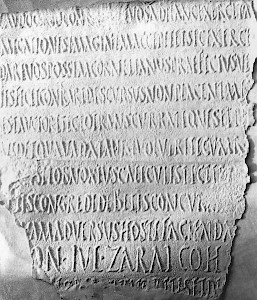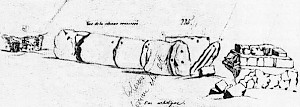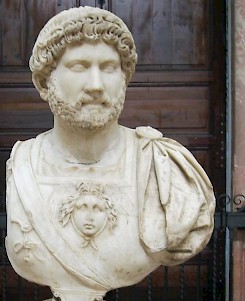Lambaesis Inscription
Lambaesis Inscription: the fragmentary text of a speech, delivered at the legionary base of Lambaesis by the emperor Hadrian to his soldiers.

Broadly speaking, students of ancient warfare can use four types of evidence. In the first place, descriptions of campaigns, found in the publications by ancient military historians like Thucydides, Caesar, or Arrian. The authors of handbooks offer descriptions of the armies, tactics, and weapons. Archaeologists have discovered ancient fortifications, weapons, and even battlefields. Finally, inscriptions help us reconstruct the careers of the soldiers and the regimental history of military units, especially of the Roman army.
The inscription from Lambaesis, a legionary base in the Northeast of what is now known as Algeria, is exceptional because it offers the information we would expect from a handbook: presented as the words of praise and admonition by an emperor to his soldiers, it describes their duties and the way to perform them. We read about javelin throwing, wall building, and a cavalry charge; we also learn minor details (watchmen could use dogs); and we get an idea about the nature of Roman class society and its influence on the army hierarchy.
However, it is possible to overstate the importance of this inscription. The visit of, a decision by, or a letter from an emperor were things to remember, and many civil communities are known to have commemorated those acts in inscriptions. The Lambaesis Inscription, although addressed to a legion and its auxiliaries, fits in this pattern. It is less unique than is sometimes claimed.
Worse, it is poorly preserved. Even worse, the emperor Hadrian's phrases are extremely artful and although most scholars believe they are a verbatim report of the words actually spoken during an inspection tour in June and July 128, it cannot be excluded that they were made a bit more eloquent, as was common when ancient orators had their speeches published. We will discuss this below.
An Incomplete Text

The inscription was carved on the square base of an honorific column erected on the parade ground outside the legionary base. It was about two meters high and its four sides were flanked by two times four text-bearing fields. If one approached the monument from the fortress, one would see the main dedication (to Imperator Caesar Hadrian Augustus and so on) in the center, surrounded by eight text fragments. A reasonable part of the text can be understood.
We know it started with a brief introduction: Hadrian, "having watched its maneuvers, addressed the Third Augustan Legion in the words written below". After this, we find a compliment to the unit's commander, Quintus Fabius Catullinus, and a word about the importance of military exercise. After this, there's a lacuna, but we understand that the emperor addressed several legionary subunits and dealt with several of their tasks. When speaking to the pili (the legionaries who were supposed to stand in the front line during a regular battle), Hadrian referred to their visits to outposts. Next came the horsemen, who are praised because they threw spears. The principes (the legionaries of the second rank) were singled out for their construction skills, and although we know that the hastati (the third rank) were also addressed, it is not known what task was allotted to them.
In the second half, we read about the auxiliaries, but only a brief fragment about archery and three longer ones about cavalry maneuvers have survived. Yet, is clear that at least six auxiliary units were mentioned in the sequence in which Hadrian visited at least three of their forts. It is unknown how the inscription ended.
Twenty-two fragments of these four speeches can be understood, another fifty fragments contain at least several words, and seventy-two fragments contain letters only - or not even that: one fragment contains just the edge of a field and a trace of what may have been an A. The incompleteness of the text is frustrating, because we're unable to know whether the addresses are all that Hadrian said, or that they are only quotes - and if the latter, from which part of the speeches.
Yet, twenty-two fragments is a fair sample and sufficient base for some conclusions. For example, addressing four types of legionaries and six types of auxiliaries, Hadrian had ten occasions to mention foot drills. Even when the inscription has survived fragmentarily, it is remarkable that he does not mention this type of exercise.
Hierarchy

One of the most striking aspects of the text is the importance of hierarchy. The emperor himself is mentioned first, followed by the legionary commander, the legionaries (in three ranks), and finally the auxiliaries. No mention is made of the civilians, although we know from the Bu Njem ostraca that the Third Augustan Legion depended heavily on merchants and guides. Apparently, Hadrian did not reckon them to the organization he was inspecting.
Of course this does not come as a surprise. The ancient world was extremely hierarchical, and the maintenance of this order was considered to be one of the most important duties of any ruler. It was important in the army as well, where comradery probably only existed between people of equal rank. We can see the hierarchy everywhere. A senator's son, acting as tribune, was second in command, even when officers from a lower social stratum had more experience. While the common soldiers had to spend the night in a small room, centurions, tribunes, and commanders lived in large mansions. Auxilaries received 5/6th of the income of legionaries; centurions, on the other hand, received fifteen times as much money as a common soldier. When it was discovered that a non-citizen was enrolled in a legion, this was a matter of greater importance than a provincial governor was allowed to deal with, even if he had received additional powers (cf. Pliny the Younger, Letters 29-30: capital punishment). Unlike the armies of the Early Modern Age, which offered upward social mobility, the Roman legions were as hierarchical as the society they had to defend.
Several aspects of the Lambaesis Inscription confirm this. For example, Hadrian consistently refers to Catullinus as legatus meus, "my deputy", and mentions that the legion's commander is a vir clarissimus, "noble man", the honorific title of a member of the senatorial order. Catullinus is not addressed as a member of the legion: he remains, although subordinated to the emperor, part of the Roman elite. On the other hand, the common soldiers are not praised for their valor and courage, but because they have perfectly done what their superiors have instructed them to do. Still, those officers were reckoned to the army: Cornelianus, the commander of an auxiliary unit, is called "your prefect", and the only reference to a centurion makes it clear that he is a fighter, not a commander.
So, the Lambaesis Inscription offers additional evidence for the already well-established fact that a legion was as hierarchical as Roman society in general. There was no bonding between the emperor and a senatorial legatus on the one hand and the rank and file on the other. It is likely that one of the reasons for erecting the Lambaesis monument was Catullinus' wish to stress, vis-à-vis his men, that he was a friend of the emperor. It was a way to reinforce the Roman order.
Speaking in Public
The social division between the Roman elite and the common people had a cultural component, which modern scholars usually call paideia. It refers to an originally Greek general program of education, training, and personal development, which gave a young man the instruments to accept responsibility for society and play a role in the political theater. And because back then, nearly all communication took place by means of the spoken word, it was absolutely imperative that one knew how to speak properly.
Of course, political oratory was dead since Augustus had created the Roman monarchy - Tacitus wrote a treatise on the subject - but there were other occasions to display one's rhetorical skills: in court, for example, or in praise of someone. There were clear rules, and among these was that the final section of a praise speech, the peroratio, ought to be especially festive, a bit artful. We can see this in Hadrian's words, which are full of internal rhyme and alliteration. Look at the two first lines of his address to the Ala I Pannoniorum:
Omnia per ordinem egistis. Campum decursionibus complestis, iaculati estis non ineleganter, hastis usi quamquam brevibus et duris.
You did everything according to the book. You filled the training ground with your wheelings, you threw spears not ungracefully, though with short and stiff spears.
Of the first twelve words, four end on -stis. In the next line, we find hic agiliter heri velociter, "today lively, yesterday swiftly". There's nothing unusual about this: a Roman senator expected this type of rhetorical refinement, while soldiers were used to this type jingle, which is, because it is easy to memorize, the common man's poetry. It is easy to understand why the Roman literary critic Fronto, who was selected by Hadrian to educate Marcus Aurelius, wrote that Hadrian spoke well in front of his soldiers,note and why the Historia Augusta states that as an orator, Hadrian had "attained the utmost proficiency and fluency".note
This rhetorical flourishing raises a question: what do the words on the stone actually represent? Does this linguistic brilliance prove that we only have quotes from the peroratio of Hadrian's speeches? Or were Hadrian's actual words improved a bit when it was decided to publish them? This question is important, because there is another remarkable aspect to the speech: most of it is praise, especially for the officers. If the surviving parts are from the concluding remarks only, we can assume that there may have been criticism as well; if, on the other hand, the fragments represent parts of all parts of the speeches, we may probably conclude that they were probably rather brief and pleasing. This has consequences for our understanding of Hadrian's self-presentation.
Drills and Dogs
The Lambaesis Inscription confirms what we learn from other sources about the training regimen of the Roman forces. Archers do not shoot at signal (as we are accustomed to see in movies) and their training is focused on shooting sharper and oftener. Legionary horsemen throw spears while wearing their lorica. An auxiliary unit is censured because it closes its rank slowly (one of the very few points of criticism). Cavalry performs an exercise known as "the Cantabricus". Some horsemen throw hasta-spears, others use lancea, and all of them are lauded because they can jump on their horses swiftly. Soldiers fight with slings and javelins. And finally, a largess is paid.
One of the longest fragments deserves to be quoted in full:
Work others would have spread out over several days, you took only one day to finish. You have built a lengthy wall, made as if for permanent winter-quarters, in nearly as short a time as if it were built from turf which is cut in even pieces, easily carried and handled, and laid without difficulty, being naturally smooth and flat. You built with big, heavy, uneven stones that no one can carry, lift, or lay without their unevenness becoming evident. You dug a straight ditch through hard and rough gravel and scraped it smooth. Your work approved, you quickly entered camp, took your food and weapons, and followed the horse who had been sent out, hailing them with a great shout as they came back.
The Roman army was an army of engineers. Another interesting aspect, is the rotation of subunits: there are always soldiers in the provincial capital and in far-flung outposts, while a cohort was sent out to reinforce a legion in Syria.
None of this is very surprising, but occasionally, we learn something new. We did not know that watch-dogs were used to guard field fortifications, while the fact that the three battle lines (pili, principes, hastate) were addressed separately and that these lines appear to have had difficult tasks, is certainly intriguing. We already noted that foot drills are not mentioned.
On one point, we discern a weakness of the Roman army, which Hadrian may not have realized. In any organization, the middle tier of the management faces the same problem: if something goes seriously wrong on the floor, they cannot ask for help from the top managers, because the highest officials will invariably blame the middlemen. As a result, the leaders of the organization never learn what is really going on. In the Roman world, where emperors were all-powerful and criticism was difficult, this problem also existed, as is evidenced by several anecdotes about Roman generals and emperors who, in disguise, mingle with the soldiers to find out what they thought about things. Seen in this light, it is troubling that Hadrian did not receive his soldiers personally, but reassured them that
Catullinus is keen in your support; everything that you might have had to put to me, he has himself told me on your behalf.
Internal communication was less important than the hierarchy, and this must have been an obstacle to the army's efficiency. (Varus' ignoring Segestes' warning about the treason by the high-ranking Arminius confirms that this danger was real.)
So, the Lambaesis Inscription is useful to understand what Roman soldiers actually did, but it must be stressed that the purpose of this text was not to offer an account of daily life in the barracks. The soldiers already knew that. The point was to reinforce discipline: the soldiers were praised because they had obeyed orders. This message is expressed most distinctly in the concluding remark of Hadrian's address to the horsemen of the Sixth Commagenian Cohort, which again must be quoted in Latin to recognize the alliteration and internal rhyme:
Catullini legati mei clarissimi viri insignis virtus apparet, quod tales vos sub illo viro viri estis.
The outstanding manhood of that noble man Catullinus, my deputy, shows itself in that under this man you are such men.
Literature
The Lambaesis Inscription is a textbook example of the poor coordination that bedevils modern scholarship. Scholars usually constitute a text first before they comment upon it. In the case of the Lambaesis Inscription, this sequence was reversed. In 2003, a team led by Yann Le Bohec published Les discours d'Hadrien à l'armée d'Afrique, which contains an updated but essentially old version of the text, a French translation, and a number of interesting articles on various aspects of the text. Three years later, Michael Speidel published Emperor Hadrian's Speeches to the African Army - a New Text, in which he constituted the text again. He proposed many new readings and was able to match several fragments. I have quoted from his translation (with some modifications). This text edition is much better, and it is therefore to be regretted that the Le Bohec team did not have access to it.
(Originally published as "Hadrian and his Soldiers. The Lambaesis Inscription", in: Core of the Legions. The Roman Imperial Centuria = Ancient Warfare Special 2010)